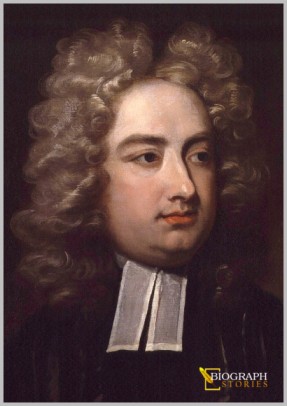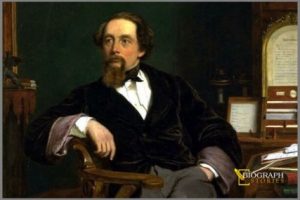
Jonathan Swift Quick Fact:
Born: 30 November 1667, Dublin, Ireland
Died: 19 October 1745 (aged 77), Dublin, Ireland
Pen name: Isaac Bickerstaff, M. B. Drapier, Lemuel Gulliver, Simon Wagstaff, Esq.
Occupation: Satirist, essayist, political pamphleteer, poet, priest
Language: English
Alma mater: Trinity College, Dublin
Biography of Jonathan Swift:
Jonathan Swift is widely known as one of the leading comedian in the English language who was also a well-known political thinker, essayist, poet and cleric. He was born in Ireland. Unfortunately from the very starting of his life, he had grown up without the shelter of his father and mostly lived with his uncle who took care of him as parents. During the Glorious Revolution in Ireland, he had to go to England and start looking for his livelihood. Eventually, he got himself involved under Sir William Temple as his employer where he found the taste of high living and power play in the society and dreamt of being in that class. In his early life, he frequently travelled back and forth between Ireland and England. Later, he entered the Church of Ireland. To secure the rights of his church, he wrote brochures and soon after that he started to enter his second big part of his life known as the political arena. After that, he went back to Ireland where he became the Dean of St. Patrick Cathedral and remained in that position until his last breath. When we talk about his writing, we find most of his works were written under pennames. Today, ‘Gulliver’s Travel’ the most and one of the famous adventure stories of all time is one of his gift to the readers all around the world.
Early Life and Education of Jonathan Swift:
Jonathan Swift the Irish author and satirist was born in Dublin, Ireland on November 30 in the year 1667. His father who was also named Jonathan Swift, died two months before he arrived. His mother went through hardship to provide for her newborn son. Additionally, from his young age, he was suffering from Meniere’s disease at that time which was a condition of the inner ear that leaves the afflicted nauseous and it becomes hard for that person to hear. In an effort to give her son the best upbringing possible, his mother handed him over to his uncle Godwin Swift who was that time a member of the respected professional attorney. Godwin Swift registered him in the Kilkenny Grammar School which was perhaps the best school in Ireland during that time. He made a fast friend with William Congreve who was about to become the future poet and playwright.
When he was 14 years old, he began his undergraduate studies at Trinity College in Dublin. In 1686, he received a Bachelor of Arts degree and went on to complete a master’s. During the time of the Glorious Revolution of 1688, Swift had to move to England and start a new life there from the beginning. There with the help of his mother, he managed to get a secretary position under the revered English statesman named Sir William Temple. For coming ten years, Swift worked as an assistant to Temple where he used to help him with political errands and also in the researching and publishing of his own essays and memoirs.
During his working there, Swift met a girl of just 8 years old named Esther Johnson .But in spite of the age gap, they would become lovers for the rest of their lives. They married in 1716.
Writings of Jonathan Swift:
While he was working for Temple, Swift returned to Ireland twice. In 1695, he started to work for becoming an ordained priest in the Anglican tradition. With the influence of Temple, he started his journey as a writer and began to write. His works then were consists of short essays and then a manuscript for books.
In 1699, after the death of Temple, Swift completed the task of editing and publishing his memoirs by several of Temple’s family members. Grudgingly, he accepted a less prominent post as secretary and minister to the Earl of Berkeley. For the next 10 years, he gardened, preached and worked on the house provided to him by the church. He also returned to writing. His first political pamphlet was titled A Discourse on the Contests and Dissentions in Athens and Rome.
In 1704, he published A Tale of a Tub and The Battle of the Books. Tub and became widely popular with the masses. Apparently, it criticized religion, but Swift meant it as a parody of pride. Nonetheless, his writings earned him a reputation in London. After a time, he became fully involved in the political landscape and began writing some of the most cutting and well-known political pamphlets of that time. His widely known works of that time were The Conduct of the Allies, an attack on the Whigs.
Later Years of Jonathan Swift:
After gaining the understanding about the fall of Tories from power, he returned to Ireland in the year 1713. There, he took the post of dean at St. Patrick’s Cathedral in Dublin. He engaged in a romantic relationship with Esther Vanhomrigh who inspired his long and storied poem named “Cadenus and Vanessa.”
Soon after that, Swift began to write what would become his best-known work known, more simply, as Gulliver’s Travels. The book was an immediate success. Interestingly, much of the storyline points to historical events that Swift had lived through years prior during intense political turmoil.
Not long after the celebration of this work, Swift’s longtime love, Esther Johnson, fell ill. She died in January 1728. Her life’s end moved Swift to write The Death of Mrs. Johnson.
Death of Jonathan Swift:
Swift suffered from a stroke in 1742. On October 19, 1745, Swift died. He was laid to rest next to Esther Johnson inside Dublin’s St. Patrick’s Cathedral.
Notables Works of Jonathan Swift:
- Gulliver’s Travels
- A Tale of a Tub
- Journal to Stella
- A Modest Proposal
- Verses on the Death of Dr. Swift
- Argument Against Abolishing Christianity
- Drapier’s Letters
- The Conduct of the Allies








